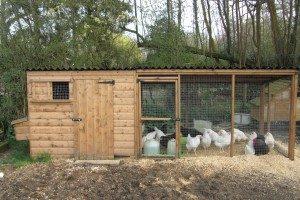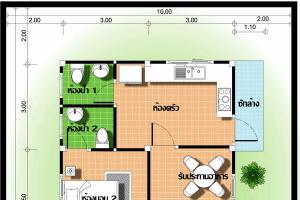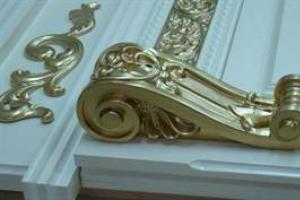Stop for longitudinal sawing.
Having perfectly aligned the saw with one of the edges of the table, I attached it with M4 screws. To do this, I had to drill the iron base of the circular in four places.
In general, any circular saw is suitable for installation on a table, but if you choose the type of fastening with screws to the base, then it is better to choose a model with iron base. Cast material may crack.
There is another popular way to attach a circular table to a table without drilling holes in the base - attach it using clamps that fix the base, pressing it to the surface. Only this method did not seem to me to be correct enough in terms of accuracy and reliability of installation, and I did not use it.
Another important parameter manual circular saw- this is the ability to connect a vacuum cleaner. If you cut without a vacuum cleaner, fine wood dust rises into the air.
The disc sawed through to the top side of the tabletop. Height - 40mm (Bosh wood disc 160mm). The table top reduces the cutting depth by 9 mm. The cutting depth is set on the circular saw itself. It’s convenient that the disc can be completely hidden in the table.
UPD: IMPORTANT! On a number of budget circular saws, it may turn out that the disk is at an imperceptible angle. And all the cuts will be beveled. Be sure to check with a tool square that the disk is at 90 degrees relative to the table surface. (before installing the saw, you can check the angle relative to the original platform. If the disk is not at a right angle and it is not possible to set the ideal angle of the site, you can place several strips of tin on one side under the platform, achieving an ideal angle (you can use washers for the screws that secure the saw to the table, but this solution is worse)
Inside the table I placed a socket for the saw, which will now be turned on by the start button.
This is how you can connect a vacuum cleaner to the saw. In general, the table is ready and you can saw. (done in one evening and one morning).
Of course, it is possible to saw without equipment, using slats and clamps, but it is inconvenient.
This structure, pressing against the edges of the table and aligning itself with them, can move along saw blade. By pressing the sled against the rail, you can easily saw it at exactly 90 degrees. Thin pieces of wood can be placed inside the sled.
You can even cut the strip like a sausage :) For example, I cut several pieces of different thicknesses.
Sleds solve only part of the problem. For longitudinal sawing you also need a side stop.
I glued together brackets from plywood that will cling to the edge of the table.
It grabs the edges with a death grip.
A circular saw is a dangerous tool. In order not to saw off my fingers, I made it from waste furniture board a simple pusher.
I have already managed to work with this table, sawing slats, furniture panels, plywood. It became much easier to do all this work than I did when sawing off with a hand-held circular saw.
In the future I will further improve this table:
- I will remake the side stop for longitudinal sawing so that, when moving, it always remains parallel to the disk
- I will install a removable riving knife to which the disk protection will be attached
- I'll make a dust extraction from the top of the table. (Now when I saw, the blade throws wood dust right in my face)
- I’ll finish the improved pusher. I have already started making a more interesting and convenient version of the pusher, I will write about this in the future.
I will gradually implement this in the future, but for now I will work like this.
This article discusses several simple but useful devices that the master made for his hand-held circular saw. At the end of the publication, for clarity, there is a video tutorial by the author of the channel “Do it yourself carpentry”.
This Chinese store is a haven for woodworkers. Plugin for the browser to save money in it: 7% -15% on purchases.
The saw used is Boch GKS 165 CE. This is, first of all, a traditional standard rip fence included with almost any hand-held circular saw. The remaining devices are various guides. This is a device for perpendicular cross cutting and banding of workpieces. This is a guide bar for cutting sheet material. Two bars - probably the most useful auxiliary devices in work are installation bars, which allow you to accurately place any guides, such as a straight-edged rail, painting rules, any straight pipe or profile, or the factory edge of any sheet material. And finally, an adjustable guide for cutting at a given angle.
I made all these devices with my own hands a long time ago, when I learned the basics of carpentry and joinery with the help of a hand-held circular saw and an electric plane. country house construction. And they still serve faithfully.
Particularly useful for working with large, long material. That is, with long boards and sheets large sizes, which are inconvenient to process on a circular saw or miter saw. The first part is about the first three devices, as the most popular. The remaining two will be covered in the second part.
So, the simplest and most common device for a hand-held circular saw is a standard stop, designed for longitudinal cutting of workpieces to a given width. But this fence has one drawback - to ensure safety, it is designed so as not to interfere with the operation of the saw guard. As a result, the stop does not allow cutting with a width less than a certain specified value. IN different models It is different for circular saws. For a saw it is 22 mm. That is, with the help of this stop it will not be possible to cut slats with a thickness of less than 22 mm. Somehow I needed to file quickly a large number of slats, 10-15 mm thick for spacers between boards in a stack. The only tool available was a circular saw. It turned out that it was impossible to do this with the help of a standard stop. Therefore, I took the first block with parallel edges that came to hand and temporarily attached it to the stop with self-tapping screws. I've been using it ever since!
Using the workpiece, you can saw off slats of any width, up to several millimeters. When working with such a modernized fence, especially when sawing less than 15 millimeters, increased safety precautions should be observed. With a small sawing width, the protective cover rests against the block and does not cover the rotating disc. Therefore, when handling a saw, in order to avoid injury, you need to be extremely careful and attentive.
Using the device is simple: set the stop to the required cutting width, secure the workpiece, press the block firmly against the edge of the board and guide the saw along the workpiece. Since such a stop can be installed almost close to the disk, replacing the pad with a longer one, about 40-50 cm, the saw can be used as an improvised jointer for quickly leveling the edge edged boards. The result is quite acceptable!
The next device is a guide for making perpendicular, transverse cuts.

It consists of the guide rail itself and a stop perpendicular to it. The cutting line is determined by the edge. The author of the idea has been using it for about 4-5 years, so the edge is very worn out, and soon we will have to make a new one. The device is made for a specific saw blade; I wrote down the parameters of my blade for memory. On the other side there is a guide for hand router, with a 12 mm cutter, but uses it extremely rarely.
He made this device to perform a specific job, namely to make carved columns for the terrace of his house. It was necessary to make many shallow perpendicular cuts on each side of the beam.
Next from 5 minutes. And the continuation in the second part.
How to do homemade table for a circular saw with your own hands according to the drawings
A hand-held circular saw is powerful tool With high performance. One of the main advantages of a circular saw - maneuverability becomes a disadvantage when it is necessary to cut large volumes of wood. To simplify the process, you can easily assemble the table for circular saw with your own hands.
Table structure

small table stand for circular saw
The design of a table for a hand-held circular saw is so simple that most craftsmen make it without preliminary drawings and diagrams. This is a sturdy workbench that is made of wood and plywood. The most reliable table bases are made of metal. They are the heaviest and require welding skills. Therefore, stands are often made from waste lumber. A circular saw is attached under the tabletop, the blade protrudes above it through a specially made slot. The lumber is advanced along the tabletop and cut with a rotating disk. For convenience and accuracy of work, the table is equipped with additional accessories: corner and longitudinal stop.
The countertop “eats” part of it work surface disc, the depth of cut will decrease by the thickness of the table top. Therefore, it is advisable to select a circular saw with a maximum disk diameter, and a table top that is thin but hard.
If you haven’t purchased a saw yet, choose models with high power (from 1200 W). They can handle cutting large volumes of wood. Holes will be drilled in the sole for mounting; the cast base may crack. Therefore, it is advisable to choose a tool with a stamped sole.
Selection of materials

mounting a circular saw under a tabletop
To make a good stand for a hand-held circular saw, you should remember your carpentry skills, be patient and have a small amount of materials:
- laminated plywood 15 - 20 mm;
- timber 50 x 50;
- board;
- switch;
- external socket;
- a piece of electrical cable;
- PVA glue;
- wood varnish (if the plywood is not laminated);
- self-tapping screws
The size of the countertop will depend on the size of the workshop. At the same time, too small table It will be inconvenient to saw long sections. If the part fits entirely on the working surface, the cut is smoother and more accurate. The height of the legs is selected depending on the height of the master.
Convenient for a small workshop tabletop design with approximate dimensions 50 x 50 x 25 cm.
Table manufacturing process
- From a sheet laminated plywood Cut out the tabletop to the required size. The markings are applied to the lower plane using a metal ruler and pencil. We cut the plywood with a jigsaw, milling the edges if necessary. If the plywood is not laminated, sand the surface of the table.
- We turn it over and make markings from the bottom for attaching a manual circular saw. To do this, remove the disc from the tool and place it with the sole in the required place. We make marks on the tabletop and on the sole for fasteners and a groove for the saw blade. Drill holes for the bolts. They will be screwed from above, through the tabletop and held in place with nuts from below. Therefore, we countersink the holes on the working surface side and grind the bolt heads so that they do not protrude.
- If you plan to cut material for different angles, the slot for the saw wheel is made in the shape of an inverted trapezoid. For smooth sawing a regular groove is made. Before cutting the slot and holes for fasteners, apply a saw, adjust the marks and only then cut.
- Mark with a pencil the locations of the stiffeners. They are made from boards and installed from below, 8 - 9 cm from the edge of the tabletop. We will attach the table legs to the ribs. The ribs are fixed with self-tapping screws at intervals of 15 - 25 centimeters, and additionally glued with PVA. Self-tapping screws are screwed in from above, through the tabletop, and the heads are completely recessed. The ribs are fastened together with long self-tapping screws.
- The legs of the table are made of a block or board; their length will be from 100 to 113 cm. Legs that diverge slightly downwards will give greater stability. They are fixed with large bolts, tightened from the outside, and secured from the inside with nuts. The timber ties will further strengthen the frame.
- To adjust the height of the table, nuts are attached to the bottom into which M14 bolts are screwed.
- Now you can fix the saw from below by inserting the disc into the prepared slot.
- Attached to inner part electrical outlet on the table, let it pass from it electrical wire and install the switch in convenient location(on the outer part of the stiffener). Power to the outlet will be supplied from the switch. We stretch a wire from it to the nearest power source in the workshop. Using a construction tie, we fix the ON-OFF button on the body of the circular saw in a recessed position.
Let's start making auxiliary stops. For longitudinal stop You will need #30 square aluminum pipe and two screws with wing nuts.
- We saw off a piece of pipe along the length of the tabletop, and cut holes for screws 3 cm from the edge.
- We cut out two clamps from pieces of plywood. The structure is ready.
- For sawing across the table, we make a plywood sled. We align them with the edges of the table, press them and move them along the toothed circle. We cut a groove where the circle passes through the slide. Small parts can be placed directly inside the slide and sawed.
Dust removal is organized from under the table, but most of At the same time, dust flies from above, so it’s a good idea to supplement the device with an upper dust extractor.
Working with a circular saw is very dangerous, so it is important to protect your fingers. Cut out a pusher from a piece of board or furniture panel.
Additions to the design

This design can be supplemented with a riving knife, which will be removed. Put a disk guard on it, which cuts off the flow of chips flying directly at the carpenter.
Some craftsmen, assembling the table according to unique drawings, the factory protective cover is completely removed, and the factory platform is replaced with a homemade one. If you do not plan to cut at an angle, you can remove all the devices for adjusting the tilt of the disk. The saw is fixed directly on the new base, which allows you to gain a few millimeters of cutting depth.
Without an internal casing, it is easier to remove the blade; the saw does not become so clogged with chips when working with raw boards. Disassembly requires extra time, but the engine resource is saved and overload is prevented.
First video about stationary table for a circular saw, the second is about a small portable structure:
Example of drawings and homemade designs
Tools for circular saw
GNTI – Felisatti FTJ – Tenoning device for circular machines – Video reports from the world of science and technology

Useful tools for the workshop » DIY crafts - do it yourself

extractor for sawdust from under machines


Chip ejector Metabo PK200/255/300. Price, buy chip ejector Metabo PK200/255/300 in Kyiv, Kharkov, Dnepropetrovsk, Odessa, For
Carpentry. Adaptations. Press on the machine – AgaClip – Make Your Video Clips
GNTI - Devices for cutting chipboard at an angle on the machine. Taper jig for the table saw. — Video reports from the world of science and technology

GNTI - Carpentry. Adaptations. Finalizing the ruler for the router - Video reports from the world of science and technology

GNTI - Accessories for a circular saw, see carpentry tricks.mp4 - Video reports from the world of science and technology
Homemade table for a manual router Construction portal

Tenon cutting device

Do-it-yourself circular saw stop

Do-it-yourself device for a hand-held circular saw

Circular machine yourself Stroitel 73 - construction portal of Ulyanovsk

DIY circular saw

Circular saw machine
Devices for planer and saws – AgaClip – Make Your Video Clips
Homemade tools for the workshop. Homemade tool… Find out more

Tenoning device for a circular table. Part 1 Products Yours homemade instrument Posted

Watch online for free Carpentry. Adaptations. Platform for video cutter (video clip, video clip) without registration and without SMS

Popular:
- Stationary jigsaw from manual
- Making a shield from wood
- Kitchen assembly video factory Maria
- Table for manual jigsaw
- Bathroom tiling ceramic tiles
- How to add a room to your house video
Very necessary equipment DIY for a circular saw
A very necessary DIY device for a circular saw » Similar videos
http://bit.ly/2h3yt1q electrical instruments from China.
http://bit.ly/2g6kcBb electrical instruments in Russia.
http://bit.ly/2gZu10N electrical tools in Ukraine.
http://fas.st/vE2wzk discounts on tools in online stores.
 Some simple devices for hand-held circular saw. Part 1
Some simple devices for hand-held circular saw. Part 1  What can be made from old files
What can be made from old files  Tenoning attachment for circular saw
Tenoning attachment for circular saw  Secrets of the ORDINARY GRINDER. Useful tips and tricks for the home handyman
Secrets of the ORDINARY GRINDER. Useful tips and tricks for the home handyman  Device for receiving decorative pattern— router jig for decorative motif
Device for receiving decorative pattern— router jig for decorative motif  Ruler for a hand-held circular saw or how to cut straight.
Ruler for a hand-held circular saw or how to cut straight.  Grooves on the circular. A simple device.
Grooves on the circular. A simple device.  Engineering Communication trial and error // FORUMHOUSE
Engineering Communication trial and error // FORUMHOUSE  Millionth table for manual circular saw
Millionth table for manual circular saw  How to make a ruler on circular saw with your own hands in a garage workshop Carpentry Masters
How to make a ruler on circular saw with your own hands in a garage workshop Carpentry Masters  Homemade adapter for filling the oil can with oil
Homemade adapter for filling the oil can with oil  A miter box for a circular saw or a do-it-yourself trimmer.
A miter box for a circular saw or a do-it-yourself trimmer.  Guide bar for circular saw (circular saw)
Guide bar for circular saw (circular saw)  How batteries for electric vehicles are made
How batteries for electric vehicles are made  simple tool for grinding knives
simple tool for grinding knives  DIY guide bar for a hand-held circular saw
DIY guide bar for a hand-held circular saw  Simple rip fence (ruler) for circular saw
Simple rip fence (ruler) for circular saw  Joiner's jig for a DIY circular saw for a garage workshop
Joiner's jig for a DIY circular saw for a garage workshop  super device for laying bricks. Nivok111 is in awe
super device for laying bricks. Nivok111 is in awe  HOW TO MAKE THE ADAPTATION FOR WOODCAR
HOW TO MAKE THE ADAPTATION FOR WOODCAR  How to make your own electrodes for welding cast iron
How to make your own electrodes for welding cast iron  My method of fixing pillars when concreting them in holes
My method of fixing pillars when concreting them in holes  A simple and necessary device for a drill in a few minutes with your own hands
A simple and necessary device for a drill in a few minutes with your own hands  HOUSE FROM SCRATCH. The foundation was insulated with EPPS | The armored belt is ready | Stairs to the basement
HOUSE FROM SCRATCH. The foundation was insulated with EPPS | The armored belt is ready | Stairs to the basement
DIY accessories for a hand-held circular saw.
These simple and very useful accessories for a hand-held circular saw -
- parallel stop,
- device for perpendicular cross cutting and trimming of boards,
- guide rail for cutting sheet material,
- locating bars for precise placement of any guide and adjustable guide for miter cuts
With the help of these devices, your hand-held circular saw can successfully replace not only a circular saw and miter saw, but also a jointer, and it will turn into a very convenient and accurate tool.
First part of the video.
Second part of the video.
- DIY sliding gates (0)
I'm using regular ones for now swing gates. And of all the automation, there is only a stop that prevents the wind from closing them. But I’m already thinking about [...] - DIY paper earrings using quilling technique (1)
Of course, earrings with “brellas” will give you more pleasure, but the proposed colorful version of them, made with your own hands from […] - Ideas for a screwdriver. How to use a screwdriver. (0)
Gradually, screwdrivers entered our lives as extremely convenient and indispensable tool. Masters continue to come up with more and more new […] - How to build frame house with your own hands. Tools. (0)
A very clear video explaining what tools are needed for construction. frame house by one person. Detailed and intelligible. What and how […] - DIY circular saw. Sawing table. (0)
For beginners. Anyone can make such a machine with their own hands. Surprisingly simple and intelligible. And you literally need one old Soviet […] - Tools for working with leather. DIY workshop for working with leather. (0)
A very useful video on organizing a workshop for working with leather. The author made many of the instruments with his own hands. Everything is cheap and cheerful. AND, […]
It’s hard to imagine a carpentry workshop without a circular saw, since the most basic and common operation is precisely longitudinal sawing blanks How to make a homemade circular saw will be discussed in this article.
Introduction
The machine consists of three main structural elements:
- base;
- sawing table;
- parallel stop.
The base and the sawing table itself are not very complicated structural elements. Their design is obvious and not so complicated. Therefore, in this article we will consider the most complex element– parallel stop.

So, the rip fence is a moving part of the machine, which is a guide for the workpiece and it is along it that the workpiece moves. Accordingly, the quality of the cut depends on the parallel stop because if the stop is not parallel, then either the workpiece or the saw blade may become jammed.
In addition, the parallel stop of a circular saw must be of a rather rigid structure, since the master makes efforts to press the workpiece against the stop, and if the stop is displaced, this will lead to non-parallelism with the consequences indicated above.

Exist various designs parallel stops depending on the methods of its attachment to circular table. Here is a table with the characteristics of these options.
| Rip fence design | Advantages and disadvantages |
| Two-point mounting (front and rear) | Advantages:· Quite rigid design, · Allows you to place the stop anywhere on the circular table (to the left or right of the saw blade); Does not require the massiveness of the guide itself Flaw:· To fasten it, the master needs to clamp one end in front of the machine, and also go around the machine and secure the opposite end of the stop. This is very inconvenient when selecting the required position of the stop and with frequent readjustment it is a significant drawback. |
| Single point mounting (front) | Advantages:· Less rigid design than when attaching the stop at two points, · Allows you to place the stop anywhere on the circular table (to the left or right of the saw blade); · To change the position of the stop, it is enough to fix it on one side of the machine, where the master is located during the sawing process. Flaw:· The design of the stop must be massive to ensure the necessary rigidity of the structure. |
| Fastening in the groove of a circular table | Advantages:· Fast changeover. Flaw:· Complexity of the design, · Weakening of the circular table structure, · Fixed position from the line of the saw blade, · Quite a complex design for self-made, especially made of wood (made only of metal). |
In this article we will examine the option of creating a parallel stop design for a circular saw with one attachment point.
Preparing for work
Before you begin, you need to decide on the necessary set of tools and materials that will be needed during the work process.
The following tools will be used for work:
- Circular saw or you can use.
- Screwdriver.
- Grinder (Angle grinder).
- Hand tools: hammer, pencil, square.
During the work you will also need the following materials:
- Plywood.
- Solid pine.
- Steel tube with an internal diameter of 6-10 mm.
- Steel rod with an outer diameter of 6-10 mm.
- Two washers with an increased area and an internal diameter of 6-10 mm.
- Self-tapping screws.
- Wood glue.
Design of a circular saw stop
The entire structure consists of two main parts - longitudinal and transverse (meaning relative to the plane of the saw blade). Each of these parts is rigidly connected to the other and is complex design, which includes a set of parts.



The pressing force is large enough to ensure the strength of the structure and securely fix the entire rip fence.

From a different angle.

The general composition of all parts is as follows:
- The base of the transverse part;
- Longitudinal part
- , 2 pcs.);
- The base of the longitudinal part;
- Clamp
- Eccentric handle
Making a circular saw
Preparation of blanks

A couple of points to note:
- flat longitudinal elements are made from, and not from solid pine, like other parts.





We drill a 22 mm hole in the end for the handle.

It is better to do this by drilling, but you can simply hammer it with a nail.

The circular saw used for work uses a homemade movable carriage made of (or, as an option, you can whip up a false table), which is not too bad to be deformed or damaged. We hammer a nail into this carriage in the marked place and bite off the head.



As a result, we get a smooth cylindrical workpiece that needs to be processed with a belt or eccentric sander.

We make a handle - it is a cylinder with a diameter of 22 mm and a length of 120-200 mm. Then we glue it into the eccentric.

Transverse part of the guide
Let's start making the transverse part of the guide. It consists, as mentioned above, of the following details:
- The base of the transverse part;
- Upper transverse clamping bar (with an oblique end);
- Lower transverse clamping bar (with an oblique end);
- End (fixing) strip of the transverse part.
Upper transverse clamping bar
Both clamping bars– the upper and lower ones have one end that is not straight 90º, but inclined (“oblique”) with an angle of 26.5º (to be precise, 63.5º). We have already observed these angles when cutting the workpieces.

The upper transverse clamping bar serves to move along the base and further fix the guide by pressing against the lower transverse clamping bar. It is assembled from two blanks.






Both clamping bars are ready. It is necessary to check the smoothness of the ride and remove all defects that interfere with smooth sliding; in addition, you need to check the tightness of the inclined edges; There should be no gaps or cracks.
With a tight fit, the strength of the connection (fixation of the guide) will be maximum.

Assembling the entire transverse part



Longitudinal part of the guide
The entire longitudinal part consists of:
- , 2 pcs.);
- The base of the longitudinal part.
This element is made from the fact that the surface is laminated and smoother - this reduces friction (improves sliding), and is also denser and stronger - more durable.

At the stage of forming the blanks, we have already sawed them to size, all that remains is to refine the edges. This is done using edge tape.

The edging technology is simple (you can even glue it with an iron!) and understandable.
The base of the longitudinal part



We also additionally fix it with self-tapping screws. Do not forget to maintain a 90º angle between the longitudinal and vertical elements.

Assembly of transverse and longitudinal parts.


Right here VERY!!! It is important to maintain an angle of 90º, since the parallelism of the guide with the plane of the saw blade will depend on it.


Installation of the eccentric





Installing the guide
It's time to attach our entire structure to the circular saw. To do this, you need to attach the cross stop bar to the circular table. Fastening, as elsewhere, is carried out using glue and self-tapping screws.



... and we consider the work finished - the circular saw is ready with your own hands.
Video
Video on which this material was made.
These simple and very useful accessories for a hand-held circular saw -
- parallel stop,
- device for perpendicular cross cutting and trimming of boards,
- guide rail for cutting sheet material,
- locating bars for precise placement of any guide and adjustable guide for miter cuts
With the help of these devices, your hand-held circular saw can successfully replace not only a circular saw and a miter saw, but also a jointer, and will become a very convenient and accurate tool.
First part of the video.
Second part of the video.
- DIY sliding gates (0)
For now I use regular swing gates. And of all the automation, there is only a stop that prevents the wind from closing them. But I’m already thinking about [...] - DIY paper earrings using quilling technique (1)
Of course, earrings with “brellas” will give you more pleasure, but the proposed colorful version of them, made with your own hands from paper […] - Developing your home tool arsenal (0)
Regardless of qualifications home handyman or his creative aspirations, he cannot do without forming the necessary arsenal […] - DIY circular saw. Sawing table. (0)
For beginners. Anyone can make such a machine with their own hands. Surprisingly simple and intelligible. And you literally need one old Soviet […]
A hand-held circular electric saw, which is simply called - handy tool for cutting and cutting lumber.
It usually comes complete with devices that help the master in his work.
But the same devices can be made or improved with your own hands. And work experience will sooner or later lead to the appearance of completely homemade devices (as they are called), which, despite their simplicity, can greatly facilitate sawing and save time.
Rip fence
Conventional rip fence for circular saws - good example how a small addition can bring significant benefits. Almost every hand-held circular saw is equipped with a rip fence for longitudinal cutting of a given width. This is a really useful device.
The standard stop has one drawback. For safety reasons, it is set to values that allow it to be used to make cuts less than 20–25 mm wide. This is done so that the stop does not interfere with the movement of the saw guard. But it is enough to attach a wooden block with self-tapping screws to the parallel strip of the standard stop - and its capabilities will increase, while minimum width cutting will not be limited in any way.
Note! We must remember about safety - when making cuts of less than 15 mm, the block does not allow protective casing cover the saw blade.
Stop for cross and corner cuts
The crosscut jig is also often used. With its help, boards are cut quickly and accurately at an angle of 90°. This type of stop is also used for cutting boards. Its base is a sheet of plywood 10 mm thick. A guide block or rail with a height of at least 20 mm is fixed to it with glue or self-tapping screws. A stop is attached to the bottom side of the base, perpendicular to the guide and made from the same block.
The excess part of the base (from the guide to the saw blade) is cut off. Since this distance is different for each model of manual circular saw, the device is always made individually. It is usually secured to the material being processed with clamps.
Advanced craftsmen make their fastening devices from wooden washers, one of which has the shape of an eccentric. The clamping is carried out by a wing nut on the screw. This clamping device allows you to very quickly secure the fence to lumber of different widths.
If you install the same block on the other side of the guide, but fixed at an angle of 45° to the first one, and then cut off part of the base with a saw at 45°, you will get a universal angular stop for cuts at both 45° and 90°. More universal design the angle stop will be obtained if the rotation of the bar is ensured. And you can monitor compliance with the angle using a protractor attached to the top. It should be noted that making a protractor for a circular saw with your own hands is a more difficult task.
Saddle stop
If you have to saw a lot of identical bars with a circular saw, then it’s worth spending time making a simple saddle stop. Its use will more than return the spent minutes. The saddle stop works especially effectively when cutting thick beams, for which the disk requires two cuts from different sides.
The saddle stop has U-shape. The base is a board 25 mm thick, its width is exactly equal to the thickness of the sawn timber.
Attached to the base side surfaces from 10 mm plywood. The width of the sidewalls must be greater than the width of the beam in order to provide support for the circular saw platform until the saw blade comes into contact with the beam.
The saddle is put on the beam at a distance from the cut marking, corresponding to the working distance to the saw blade, and is pressed through the sidewalls to the beam with clamps. Using the side as a support for the saw platform, cutting is carried out. If the thickness of the timber is such that one cut is not enough, then it is turned over and another cut is made. The position of the stop does not change in any way.
Guide rail
For cutting large and long sheet lumber on the table, a long DIY circular saw guide bar will be useful.
The basis in this case is (8–10 mm) plywood strip length exceeding the dimensions of the sheet being cut. The tire itself can be wooden (a block 15–20 mm thick) or metal from a U-shaped profile. The tire is attached to the base with glue or screws. On one side of it there should be a narrow edge of the base, sufficient for fastening to the sheet with clamps. On the other side, the first cut is made with a saw along the base. After this, the edge of the base will exactly coincide with the passage of the circular disk. When working, it is combined with the markings on the sheet, the stop is secured and the sheet is sawed.
Edge stop
This is already a rather complex device that requires time and precision in manufacturing. It allows you to cut parallel to the edge of the material being cut. It will be useful to make a drawing of it before starting work so as not to miss the dimensions. Actually, such a stop is included in the circular saw kit, but its short length does not always ensure an even cut. The large size and the desired strength require the base of the stop to be made of plywood with a thickness of at least 15 mm. You can also make a thrust bar from it.
Stages of manufacturing the stop:
- longitudinal grooves for dowels are made at the base;
- hardwood dowels are mounted on a stop strip;
- between longitudinal grooves another through groove is made to secure the thrust bar during operation;
- a hole is cut in the base for a circular saw blade;
- On the sides of the base, restrictive strips are placed for installing the circular and clamps are provided to secure it securely.
When installing the stop on the material being processed, the stop bar moves in the grooves of the base to the required distance and is secured through the through slot with a clamping wing screw. In order not to have to worry about the ruler every time, you can attach it (or a piece of tape measure) to the base of the stop along the guide grooves.
There are such small devices, which is shameful even to consider as a tool. At the same time, they are great for cutting. These are the tricks of experienced masters.
Installation bars
The simplest part that makes it easier to install any stop and guide along the markings is a small cross-section block. There are cuts on it, the distance between which is equal to the segment from the end of the saw sole to the saw blade. Two such bars will help you install any guides quickly and accurately at the required distance from the marking line. All that remains is to secure the guide.
Pull-out protection
The protection can be any block whose width corresponds to the thickness of the workpiece being cut. If it is secured at the point where the saw blade exits the material being processed, it will act as a limiter and serve as protection against tearing out and chipping.
These devices are not limited to the set useful homemade products, which facilitate manual work circular saw. These are the easiest to make. Others require time and skill. But craftsmen even make such a device as a protractor for a circular saw with their own hands. There would be a desire.








